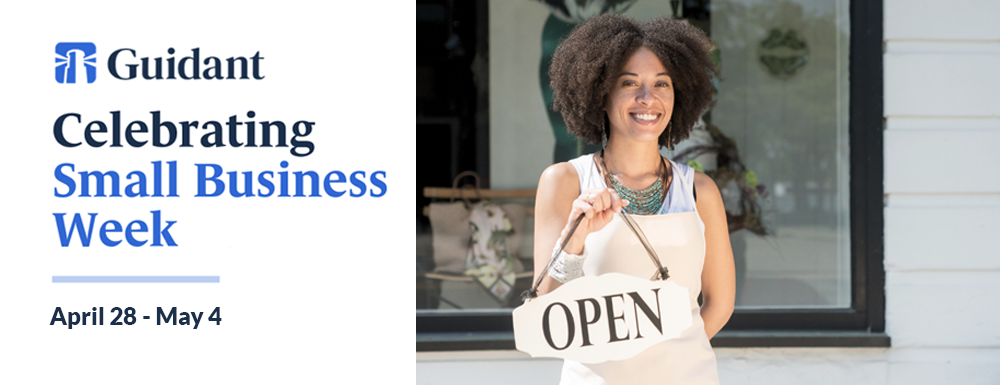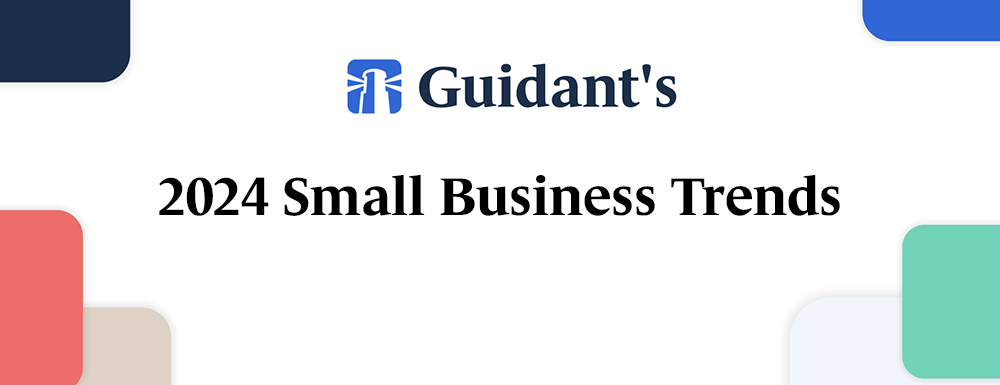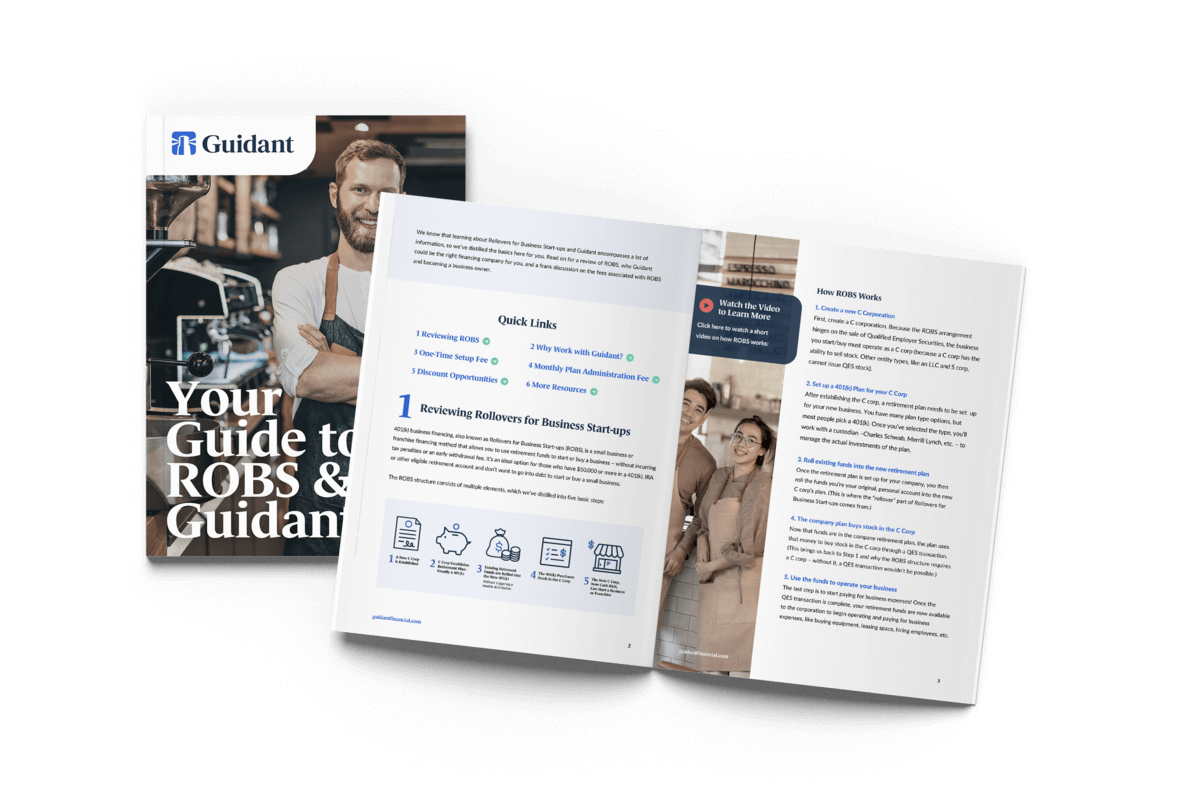2022 Women in Business Trends
A look at women-owned small businesses in 2022
Each year, Guidant reaches out to the resilient, hardworking small business owners of America. We learn who they are, what their lives as small business owners are like, what their plans for the future are, and how their business has weathered current affairs. We are especially interested in supporting and reporting about underserved segments of the population, such as women and entrepreneurs of color. Together, this information makes up the Small Business Trends report.

Who are Women in Small Business 2022?
Why do women start their own businesses? It turns out, they have the same reasons as anyone else. Women in business most often began their own business because they were ready to be their own boss (57.89%). They also found themselves dissatisfied with corporate America (37.72%) and were ready to pursue their passion (29.82%). Roughly 21% of found themselves either bored or financially insecure, stating that they started their business because they weren’t ready to retire.
The only significant difference is that women were 7% more likely to snatch up an opportunity than the average business owner.
Despite the extra challenges of being a woman in business, women are just as happy as other business owners. The overwhelming majority (73.68%) of women business owners report being somewhat or very happy. Roughly 17% of women business owners reported being somewhat or very unhappy, and the remaining 8.77% were neutral.

Generation Gap
Women completely bucked the typical generation gap. While the average business owner was equally likely to belong either to Gen X or the Baby Boomers, women are 23% more likely to be a part of Gen X. In total, 68.93% of our women respondents were Gen X, 19.42% were Boomers, and 10.68% were Millennials, making this our youngest-skewing segment by far.
Does this mean the future of small business is female? Not entirely. Women were still the minority in both Gen X (25.72%) and Millennial segments (26.19%). This would hint, however, that they may be claiming a larger piece of the future small business pie.

Women of Color in Business
 Of our women respondents, 83% identified as White or Caucasian. Black or African-American respondents made up 8.46% of respondents. Latino, Hispanic, or Spanish Origin; Asian or Asian-American, and Indigenous American were all less than 3% of our respondents. Less than 2% of respondents identified as Middle Eastern or North African, and we had no women respondents who identified as Native Hawaiian or Pacific Islander.
Of our women respondents, 83% identified as White or Caucasian. Black or African-American respondents made up 8.46% of respondents. Latino, Hispanic, or Spanish Origin; Asian or Asian-American, and Indigenous American were all less than 3% of our respondents. Less than 2% of respondents identified as Middle Eastern or North African, and we had no women respondents who identified as Native Hawaiian or Pacific Islander.While the previous year’s report indicated a rise in the diversity of small business owners, there is no data to support that trend this year. Whether this reflects the effects of the pandemic or the difference in this year’s sampling methods, we cannot say.
Guidant aims to increase the number of people who succeed in small business, especially and including entrepreneurs of color, women in business, and other underserved minorities. We sincerely hope the diversity of these figures will increase in the years to come.
Political Affiliation
Politically, women were far more likely to strongly identify with a single party. Only 2.20% of women stated that they didn’t belong or feel represented by any political party, compared to 31.87% on average! Women were also more likely to identify as Democratic than the average (50.55% compared to 22%). The remaining respondents were largely Republican (42.86%). Less than 5% identified as Libertarian, and no respondents identified as Green.


What are Women-Owned Businesses Like in 2022?
As reported above, women were younger than our average respondent. Their businesses, however, were not significantly aged differently. Just over 49% of businesses owned by women were between 0 and 5 years old (compared to 51.61% on average). Seventeen-point-five percent of businesses were 6 to 10 years old (compared to 22.68% on average). Finally, only 12.28% were 11 to 15 years old, 5.26% were 16 to 20 years old, and 6.14% were 20+ years old.
Taken as a whole, women were slightly more likely to own a business 10 years or older (23.68% compared to 18.53%).


Independence
Women who own an independent business were more likely to have started it from scratch (33.33%) as opposed to buying an existing independent business (22.81%, compared to the average of 31.76%). As with our total respondent segment, respondents were more likely to have an independent location (56.14%) than a franchise location (43.86%).
Women who do own a franchise location were by far more likely to have started their own location (34.21%) than have purchased an existing franchise location (9.65%). This is normal — it’s far more common for franchise location owners to begin a new location rather than buy a previous one.
Industry
The majority of women small business owners worked in Retail (storefront, eCommerce, etc.) at 22.32%. The second largest category was Health, Beauty, and Fitness Services at 16.07%. The remaining three in the top five industry categories were Business Services (12.50%), Food and Restaurant (11.61%), and Education and Training (5.36%). The remaining fourteen categories were less than 5%.


Profitability and Growth
This year, 59.22% of women reported that their business was currently profitable. Given the challenges of the past few years, it’s little surprise that 35% of business owners report that their business is not profitable. Don’t fret too much, though — remember that more than half of businesses surveyed are 5 years old or younger. Given that folk wisdom states businesses usually take two or three years to become profitable, it’s too early to worry that many of them not to have hit that mark yet.
Regardless of who or who is not profitable, women business owners honed in on three main strategies this year: increasing their staff (58.33%), investing in digital marketing (37.04%), and expanding or remodeling their businesses (31.48%). More women are interested in expanding their staff than the average respondent by about 7%. Fewer women are expanding or remodeling their business than the average respondent by about 8%.
Women primarily want to focus on growing their current location or service (49.07%). Others are focused on simply sustaining the condition or their current location 30.56%. Only 8.33% are entertaining expansion into a new location or service compared to the average of 12.10%. Twelve percent are considering selling their business completely.
Though hiring has been difficult this year, recruiting and retaining skilled staff seems to be a focus for all segments. Aspiring business owners will have a leg up if they prioritize these three — securing reliable staff, investing in digital marketing, and a competitive customer experience at the outset.


Hiring During the Great Resignation
Hiring this year was a challenge for everyone, and women business owners are no different. The top challenges for women business owners this year were recruiting/retention (54.39%), changing operations in the face of COVID-19 (41.23%), and lack of capital/cash flow (35.09%). Significantly more women reported struggling with changing operations due to COVID-19 (an increase of roughly 9% over the average of 32.14%). This could be related to the higher percentage of Health, Beauty, and Fitness services owned by women business owners.
When asked how difficult the hiring process was during the past year, 69.86% of women said it was somewhat or very difficult. Only 9.59% said the hiring process was easy, and the remaining 24.66% said hiring this year was the same level of difficulty as other years.
When asked about the reasons behind this difficulty, most women business owners reported a low number of applicants (63.53%), a lack of needed work experience (27.91%), or a lack of the right workplace soft skills (e.g. communication, etc; 25.58%). Competition from other employers was also a major factor at 23.26%, as was an inability to offer competitive salaries or benefits (19.77%). Women were more likely to have concerns about the soft skills of candidates in general.




The Response of Women-Owned Businesses
In response to the challenges of hiring and retaining staff this year, women-owned small businesses increased compensation (63.53%) and worked to improve retention of the employees they already had (32.94%). They also expanded recruitment efforts in general (22.35%) and even increased benefits packages and hiring bonuses (both 17.65%). This behavior is in line with our average respondent.
What Skills do Candidates Lack?
The five most critical employee skills reported by women business owners were communication (56.85%), sales (46.08%), and teamwork (46.08%). Critical thinking (42.16%) and adaptability (39.22%) were also significant. Time management was chosen as critical by 25.49% of respondents. The remaining skills were all chosen by less than 20% of respondents. There was no significant difference between women and our average respondent.
Other Challenges
Behind retention and recruitment, the top three challenges were lack of capital/cash flow (30.41%), changing operations in response to COVID-19 (28.57%), and marketing/advertising (22.58%). Fewer franchisees reported struggling with changing COVID-19 operations than independent business owners. It’s possible this was due to corporate franchise guidance.
Is the Pandemic Still Having an Effect on Women-owned Businesses?


Most women feel the pandemic’s impact on their business is not yet over (49.12%). Thirty-one percent are unsure whether the pandemic’s impact is over, and 20.18% are confident that it has. Nonetheless, 82.30% expect to survive the pandemic. Only 2.65% feel they won’t survive.
As for all segments, women felt the future was a bit murky. Forty-five percent were somewhat confident in the future, and 27.56% were somewhat unconfident. Five percent were very unconfident, and we had the same percentage of confident respondents on the other side (5%). The remaining 18% was neutral.
When considering the political situation, women small business owners remained hesitant. Ten percent were very unconfident, 30.71% were somewhat unconfident, 20.47% were neutral, 34.65% were somewhat confident, and 3.94% were very confident. This is also in alignment with our average respondent.
Women remain committed to holding the rudder steady until the storm passes. Though they’re not sure when or how these challenges will end, they’re confident they’ll make it through.
The Future of American Franchising
Small business drives 46.8% of private workforce employment and has been the backbone of the COVID recovery. According to our survey, less than a quarter of small businesses furloughed or laid-off employees. Small business is the lifeblood of America.
While it seems clear that the worst of the COVID-19 pandemic and the Great Resignation are behind us, small business has never been easy. If you’re an aspiring small business owner, Guidant can help you get started. If you’re a small business owner ready to make your life easier, now is the time. You didn’t start a small business to get stuck doing administrative work.
Trending
Your new life is right around the corner.
Together, we can get your business off the ground — no matter where you are in the small business process.
















